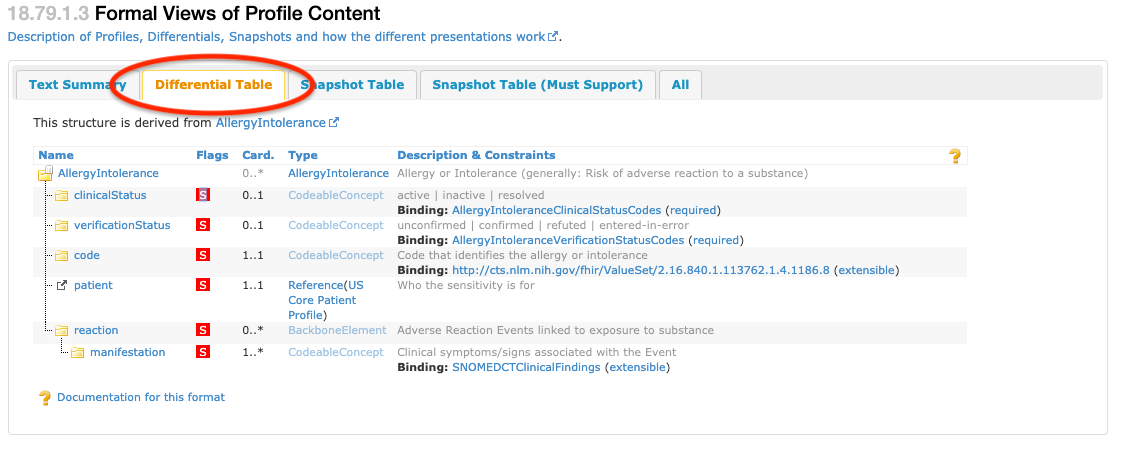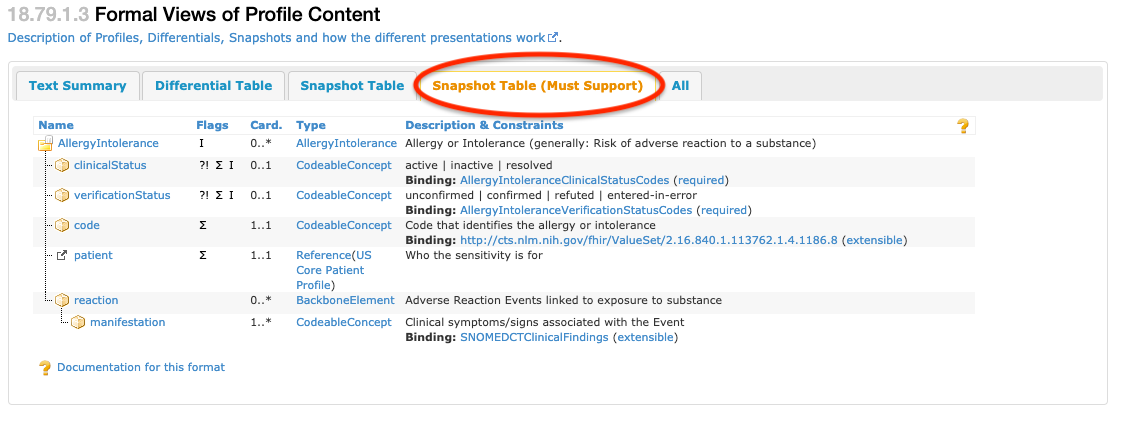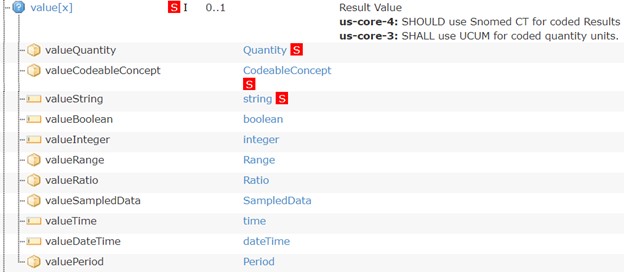This page is part of the US Core (v3.2.0: STU4 Ballot) based on FHIR (HL7® FHIR® Standard) R4. The current version which supersedes this version is 8.0.1. For a full list of available versions, see the Directory of published versions. Page versions: R4
This section outlines important definitions, interpretations, and requirements common to all US Core actors used in this guide. The conformance verbs - SHALL, SHOULD, MAY - used in this guide are defined in FHIR Conformance Rules.
The base FHIR Must Support guidance requires specifications define exactly the support expected for elements labeled Must Support.
This page defines the rules for interpreting profile elements and subelements labeled Must Support for requesters and responders.
Each profile provides a several different formal views of all the must support elements in a tree format under tabs labeled “Differential Table”, “Snapshot Table”, and “Snapshot Table (Must Support)”.
The elements labeled Must Support in the “Differential Table” view are flagged with an S. An example of this is illustrated in figure 1.

In the “Snapshot Table” view in Figure 2, all the must support elements defined for the profile , and any mandatory or must support elements inherited from a base profile (e.g. US Core Body Height Profile based on Vital Signs Profile), are flagged with an S. An example of the “Snapshot Table” is shown in figure 2.

In the “Snapshot Table (Must Support)” view, all the elements presented in the view are either mandatory or must support elements for conformance to the profile . These elements are defined in the US Core Profile, mandatory elements inherited from the base specification and, for the US Core Vital Signs profiles, any mandatory or must support elements inherited from the FHIR base Vital Signs profile. An example of the “Snapshot Table (Must Support)” is shown in figure 3.

To claim conformance to a US Core Profile US Core Servers SHALL:
When an element is mandatory (min=1), the data is expected to always be present. Very rarely it may not be, and specific guidance is provided for missing data. The convention in this guide is to mark all min=1 elements as must support unless the are nested under optional element. An example of this is CarePlan.status.
For querying and reading US Core Profiles, Must Support on any profile data element SHALL be interpreted as follows (see the Future of US Core page for writing and updating US Core Profiles.) :
The terms US Core Responder Actor US Core Requestor Actor are used throughout the guide and typically refer to a server or a client.
Readers are advised to understand FHIR Terminology requirements, FHIR RESTful API based on the HTTP protocol, along with FHIR Data Types, FHIR Search and FHIR Resource formats before implementing US Core requirements.
In addition the guidance provided by FHIR Terminology, Coded elements (CodeableConcept, Coding, and code datatypes) marked as Must Support following the rules for their respective bindings.
Required binding to a value set definition means that one of the codes from the specified value set SHALL be used. For CodeableConcept using only text is not valid, but multiple codings (translations) are permitted as is discussed below.
For example, the US Core AllergyIntolerance Profile clinicalStatus element has a required binding to the AllergyIntoleranceClinicalStatusCodes ValueSet. When claiming conformance to this profile:
AllergyIntolerance.clinicalStatus.code.US Core Requestors SHALL be capable of processing the code in AllergyIntolerance.clinicalStatus.code.

Extensible Binding to a value set definition means that one of the codes from the specified value set SHALL be used if the concept applies, but if no suitable code exists in the value set, alternate code(s) may be provided in its place. For CodeableConcept multiple codings are permitted and this rule applies to one of the codings. Also for CodeableConcept if only text is available, then just text may be used.
For example, the US Core AllergyIntolerance Profile code element has an extensible binding to the VSAC ValueSet “Common substances for allergy and intolerance documentation including refutations” Allergy. When claiming conformance to this profile:
AllergyIntolerance.code.code if the concept exists in the value setAllergyIntolerance.code.textif only text is available.US Core Requestors SHALL be capable of processing the code in AllergyIntolerance.code.code or text in AllergyIntolerance.code.text

Alternate codes may be provided in addition to the standard codes defined in required or extensible value sets. The alternate codes are called “translations”. These translations may be equivalent to or narrower in meaning to the standard concept code.
Example of multiple translation for Body Weight concept code.
"code": {
"coding": [
{
"system": "http://loinc.org", //NOTE:this is the standard concept defined in the value set//
"code": "29463-7",
"display": "Body Weight"
},
//NOTE:this is a translation to a more specific concept
{
"system": "http://loinc.org",
"code": "3141-9",
"display": "Body Weight Measured"
},
//NOTE:this is a translation to a different code system (Snomed CT)
{
"system": "http://snomed.info/sct",
"code": “364589006”,
"display": "Body Weight"
}
//NOTE:this is a translation to a locally defined code
{
"system": "http://AcmeHealthCare.org",
"code": “BWT”,
"display": "Body Weight"
}
],
"text": "weight"
},
Example of translation of CVX vaccine code to NDC code.
"vaccineCode" : {
"coding" : [
{
"system" : "http://hl7.org/fhir/R4/sid/cvx",
"code" : "158",
"display" : "influenza, injectable, quadrivalent"
},
{
"system" : "http://hl7.org/fhir/R4/sid/ndc",
"code" : "49281-0623-78",
"display" : "FLUZONE QUADRIVALENT"
}
]
},
The StructureDefinitions define the US Core Profiles and the ElementDefinition.pattern which is used almost exclusively for the CodeableConcept and Coding datatypes. If the element is marked as must support and defined by a pattern then the pattern defines the elements and element values that the server SHALL be capable of providing.
For example the US Core DiagnosticReport Profile for Laboratory Results Reporting category element is defined with a pattern requiring fixed values in DiagnosticReport.category.coding.system and DiagnosticReport.category.coding.code for a Coding element. When claiming conformance to this profile:
DiagnosticReport.categoryUS Core Requestors SHALL be capable of processing these values DiagnosticReport.category

Primitive elements are are single elements with a primitive value. If they are marked as must support, then the server SHALL be capable of providing the element value to meet the must support requirement.
For example, the [US Core DiagnosticReport Profile] issued element is a primitive instant datatype. When claiming conformance to this profile:
DiagnosticReport.issuedUS Core Requestors SHALL be capable of processing the value DiagnosticReport.issued

Complex element are composed of primitive and/or other complex elements. This page provides guidance for the following complex datatypes:
For any complex element marked as must support, The server SHALL be capable of providing at least one of the sub-element values. If any sub-element is mark as must support it must meet the must support requirements as well and it satisfies the must support requirement for the parent element.
For example, the US Core DiagnosticReport Profile for Report and Note exchange presentedForm element is labeled must support and has no must support sub-elements. When claiming conformance to this profile:
DiagnosticReport.presentedForm sub-element.US Core Requestors SHALL be capable of processing the value in DiagnosticReport.presentedForm.

For example, the US Core Patient Profile name element is labeled must support and has must support sub-elements “family” and “given”. When claiming conformance to this profile:
Patient.name.family and Patient.name.given.US Core Requestors SHALL be capable of processing the value in value in Patient.name.family and Patient.name.given.

Systems can support the other elements, but this is not a requirement of US Core. The U.S. Core Data for Interoperability (USCDI) v1 may require other elements, for example suffix.
In certain profiles only specific resource references are labeled as Must Support.
For example, the US Core DocumentReference Profile author US Core Practitioner Profile is labeled Must Support. When claiming conformance to the US Core DocumentReference Profile:
Systems can support other references but this is not a requirement of US Core.

In certain profiles only a single resource reference is present on an element labeled Must Support.
For example, the US Core AllergyIntolerance Profile patient is labeled Must Support. When claiming conformance to the US Core AllergyIntolerance Profile:

In certain profiles only specific elements are labeled as Must Support.
For example, the US Core Laboratory Result Observation Profile effectiveDateTime is labeled Must Support. When claiming conformance to the US Core Laboratory Result Observation Profile:
Systems can support the other elements, but this is not a requirement of US Core.

For the US Core Laboratory Result Observation Profile value element, multiple elements are labeled Must Support.
When claiming conformance to the US Core Laboratory Result Observation Profile:
Systems can support the other elements, but this is not a requirement of US Core.

There are several instances in this Guide where there is a choice of supporting one or another profile element to meet the must support requirement. For Example:
MedicationRequest.reportedBoolean, or a reference using MedicationRequest.reportedReference to Practitioner or other resource. Although both are marked as must support, servers are not required to support both a boolean and a reference, but SHALL choose to support at least one of these elements.Encounter.location.location or indirectly through the Organization referenced by Encounter.serviceProvider. Although both are marked as must support, servers are not required to support both Encounter.location.location and Encounter.serviceProvider, but they SHALL support at least one of these elements.The client application SHALL support both elements. There is no way to define this in a computable way, but these instances are clearly documented.